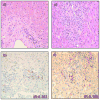Allospecific CD154+ T cells associate with rejection risk after pediatric liver transplantation
- PMID: 18976293
- PMCID: PMC2997472
- DOI: 10.1111/j.1600-6143.2008.02459.x
Allospecific CD154+ T cells associate with rejection risk after pediatric liver transplantation
Abstract
Antigen-specific T cells, which express CD154 rapidly, but remain untested in alloimmunity, were measured with flow cytometry in 16-h MLR of 58 identically-immunosuppressed children with liver transplantation (LTx), to identify Rejectors (who had experienced biopsy-proven rejection within 60 days posttransplantation). Thirty-one children were sampled once, cross-sectionally. Twenty-seven children were sampled longitudinally, pre-LTx, and at 1-60 and 61-200 days after LTx. Results were correlated with proliferative alloresponses measured by CFSE-dye dilution (n = 23), and CTLA4, a negative T-cell costimulator, which antagonizes CD154-mediated effects (n = 31). In cross-sectional observations, logistic regression and leave-one-out cross-validation identified donor-specific, CD154 + T-cytotoxic (Tc)-memory cells as best associated with rejection outcomes. In the longitudinal cohort, (1) the association between CD154 + Tc-memory cells and rejection outcomes was replicated with sensitivity/specificity 92.3%/84.6% for observations at 1-60 days, and (2) elevated pre-LTx CD154 + Tc-memory cell responses were associated with significantly increased incidence (p = 0.02) and hazard (HR = 7.355) of rejection in survival/proportional hazard analysis. CD154 expression correlated with proliferative alloresponses (r = 0.835, p = 7.1e-07), and inversely with CTLA4 expression of allospecific CD154 + Tc-memory cells (r =-0.706, p = 3.0e-05). Allospecific CD154 + T-helper-memory cells, not CD154 + Tc-memory, were inhibited by increasing Tacrolimus concentrations (p = 0.026). Collectively, allospecific CD154 + T cells provide an estimate of rejection risk in children with LTx.
Figures







Similar articles
-
Allospecific CD154+ T cells identify rejection-prone recipients after pediatric small-bowel transplantation.Surgery. 2009 Aug;146(2):166-73. doi: 10.1016/j.surg.2009.04.006. Epub 2009 Jun 26. Surgery. 2009. PMID: 19628070
-
Proliferative alloresponse of T-cytotoxic cells identifies rejection-prone children with steroid-free liver transplantation.Liver Transpl. 2009 Aug;15(8):978-85. doi: 10.1002/lt.21775. Liver Transpl. 2009. PMID: 19642137 Free PMC article.
-
Allospecific CD154+ T-cytotoxic memory cells identify recipients experiencing acute cellular rejection after renal transplantation.Transplantation. 2011 Aug 27;92(4):433-8. doi: 10.1097/TP.0b013e318225276d. Transplantation. 2011. PMID: 21747326
-
The role of CD154 in organ transplant rejection and acceptance.Philos Trans R Soc Lond B Biol Sci. 2001 May 29;356(1409):691-702. doi: 10.1098/rstb.2001.0855. Philos Trans R Soc Lond B Biol Sci. 2001. PMID: 11375072 Free PMC article. Review.
-
The Inhibition of CD40/CD154 Costimulatory Signaling in the Prevention of Renal Transplant Rejection in Nonhuman Primates: A Systematic Review and Meta Analysis.Front Immunol. 2022 Apr 7;13:861471. doi: 10.3389/fimmu.2022.861471. eCollection 2022. Front Immunol. 2022. PMID: 35464470 Free PMC article.
Cited by
-
Antithymocyte globulin facilitates alloreactive T-cell apoptosis by means of caspase-3: potential implications for monitoring rejection-free outcomes.Transplantation. 2015 Jan;99(1):164-70. doi: 10.1097/TP.0000000000000289. Transplantation. 2015. PMID: 25531894 Free PMC article.
-
A network-based approach to identify expression modules underlying rejection in pediatric liver transplantation.Cell Rep Med. 2022 Apr 19;3(4):100605. doi: 10.1016/j.xcrm.2022.100605. eCollection 2022 Apr 19. Cell Rep Med. 2022. PMID: 35492246 Free PMC article.
-
Alloreactive CD154-expressing T-cell subsets with differential sensitivity to the immunosuppressant, belatacept: potential targets of novel belatacept-based regimens.Sci Rep. 2015 Oct 16;5:15218. doi: 10.1038/srep15218. Sci Rep. 2015. PMID: 26472085 Free PMC article.
-
Strategies for Deliberate Induction of Immune Tolerance in Liver Transplantation: From Preclinical Models to Clinical Application.Front Immunol. 2020 Jul 31;11:1615. doi: 10.3389/fimmu.2020.01615. eCollection 2020. Front Immunol. 2020. PMID: 32849546 Free PMC article. Review.
-
Clinical Hepatocyte Transplantation: What Is Next?Curr Transplant Rep. 2017 Dec;4(4):280-289. doi: 10.1007/s40472-017-0165-6. Epub 2017 Oct 14. Curr Transplant Rep. 2017. PMID: 29732274 Free PMC article.
References
-
- Newell KA, Larsen CP. Tolerance assays: measuring the unknown. Transplantation. 2006;81:1503–09. - PubMed
-
- Martin SR, Atkison P, Anand R, Lindblad AS SPLIT Research Group. Studies of pediatric liver transplantation 2002: patient and graft survival and rejection in pediatric recipients of a first liver transplant in the United States and Canada. Pediatr Transplant. 2004;8:273–83. - PubMed
-
- Abu-Elmagd KM, Zak M, Stamos JM, Bond GJ, Jain A, Ezzelarab M, Mazariegos GV, Sindhi R, Marcos A, Demetris AJ, Fung JJ, Reyes JD. De novo malignancies after intestinal and multivisceral transplantation. Transplantation. 2004;77:1719–25. - PubMed
Publication types
MeSH terms
Substances
Grants and funding
LinkOut - more resources
Full Text Sources
Other Literature Sources
Medical
Molecular Biology Databases

